Health Ethics: Case Study 4 - End-of-Life Care Analysis
VerifiedAdded on 2021/05/31
|8
|2042
|58
Essay
AI Summary
This essay provides an in-depth analysis of Health Ethics Case Study 4, which revolves around the ethical challenges encountered in end-of-life care, specifically concerning a patient born with encephalomyopathy mitochondrial DNA depletion syndrome (MDDS). The essay explores the ethical issues surrounding withholding medication and allowing natural death, highlighting the dilemmas faced by healthcare professionals. It delves into the ethical principles of human dignity, human rights, professional codes, and healthcare ethics, emphasizing the importance of justice, patient rights, and adherence to professional policies. The essay also offers recommendations for professional practice, including the significance of informed consent, patient autonomy, and the use of advance directives to navigate complex end-of-life decisions. The analysis draws upon various sources to support its arguments, providing a comprehensive understanding of ethical considerations in healthcare practice.
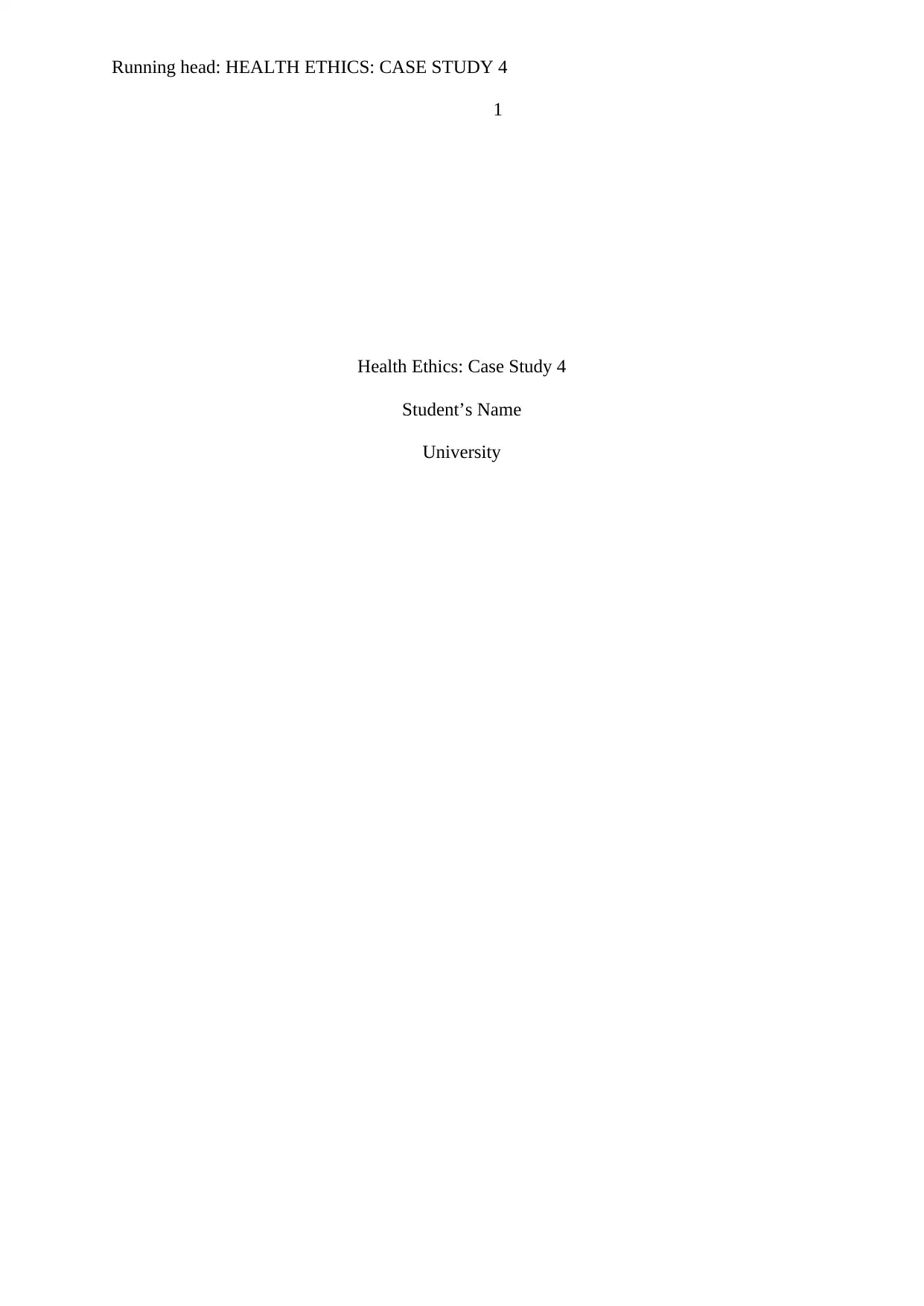
Running head: HEALTH ETHICS: CASE STUDY 4
1
Health Ethics: Case Study 4
Student’s Name
University
1
Health Ethics: Case Study 4
Student’s Name
University
Paraphrase This Document
Need a fresh take? Get an instant paraphrase of this document with our AI Paraphraser
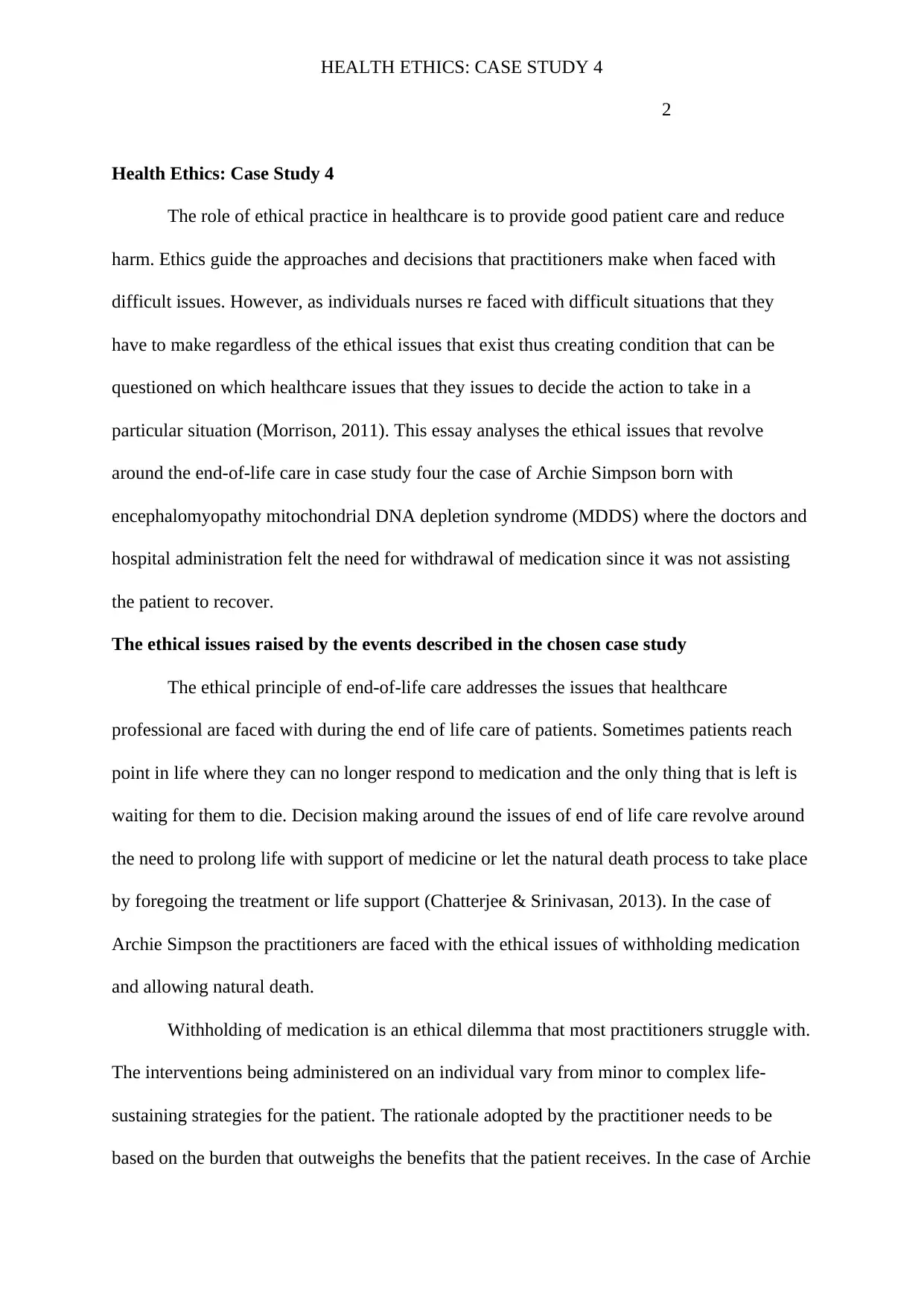
HEALTH ETHICS: CASE STUDY 4
2
Health Ethics: Case Study 4
The role of ethical practice in healthcare is to provide good patient care and reduce
harm. Ethics guide the approaches and decisions that practitioners make when faced with
difficult issues. However, as individuals nurses re faced with difficult situations that they
have to make regardless of the ethical issues that exist thus creating condition that can be
questioned on which healthcare issues that they issues to decide the action to take in a
particular situation (Morrison, 2011). This essay analyses the ethical issues that revolve
around the end-of-life care in case study four the case of Archie Simpson born with
encephalomyopathy mitochondrial DNA depletion syndrome (MDDS) where the doctors and
hospital administration felt the need for withdrawal of medication since it was not assisting
the patient to recover.
The ethical issues raised by the events described in the chosen case study
The ethical principle of end-of-life care addresses the issues that healthcare
professional are faced with during the end of life care of patients. Sometimes patients reach
point in life where they can no longer respond to medication and the only thing that is left is
waiting for them to die. Decision making around the issues of end of life care revolve around
the need to prolong life with support of medicine or let the natural death process to take place
by foregoing the treatment or life support (Chatterjee & Srinivasan, 2013). In the case of
Archie Simpson the practitioners are faced with the ethical issues of withholding medication
and allowing natural death.
Withholding of medication is an ethical dilemma that most practitioners struggle with.
The interventions being administered on an individual vary from minor to complex life-
sustaining strategies for the patient. The rationale adopted by the practitioner needs to be
based on the burden that outweighs the benefits that the patient receives. In the case of Archie
2
Health Ethics: Case Study 4
The role of ethical practice in healthcare is to provide good patient care and reduce
harm. Ethics guide the approaches and decisions that practitioners make when faced with
difficult issues. However, as individuals nurses re faced with difficult situations that they
have to make regardless of the ethical issues that exist thus creating condition that can be
questioned on which healthcare issues that they issues to decide the action to take in a
particular situation (Morrison, 2011). This essay analyses the ethical issues that revolve
around the end-of-life care in case study four the case of Archie Simpson born with
encephalomyopathy mitochondrial DNA depletion syndrome (MDDS) where the doctors and
hospital administration felt the need for withdrawal of medication since it was not assisting
the patient to recover.
The ethical issues raised by the events described in the chosen case study
The ethical principle of end-of-life care addresses the issues that healthcare
professional are faced with during the end of life care of patients. Sometimes patients reach
point in life where they can no longer respond to medication and the only thing that is left is
waiting for them to die. Decision making around the issues of end of life care revolve around
the need to prolong life with support of medicine or let the natural death process to take place
by foregoing the treatment or life support (Chatterjee & Srinivasan, 2013). In the case of
Archie Simpson the practitioners are faced with the ethical issues of withholding medication
and allowing natural death.
Withholding of medication is an ethical dilemma that most practitioners struggle with.
The interventions being administered on an individual vary from minor to complex life-
sustaining strategies for the patient. The rationale adopted by the practitioner needs to be
based on the burden that outweighs the benefits that the patient receives. In the case of Archie
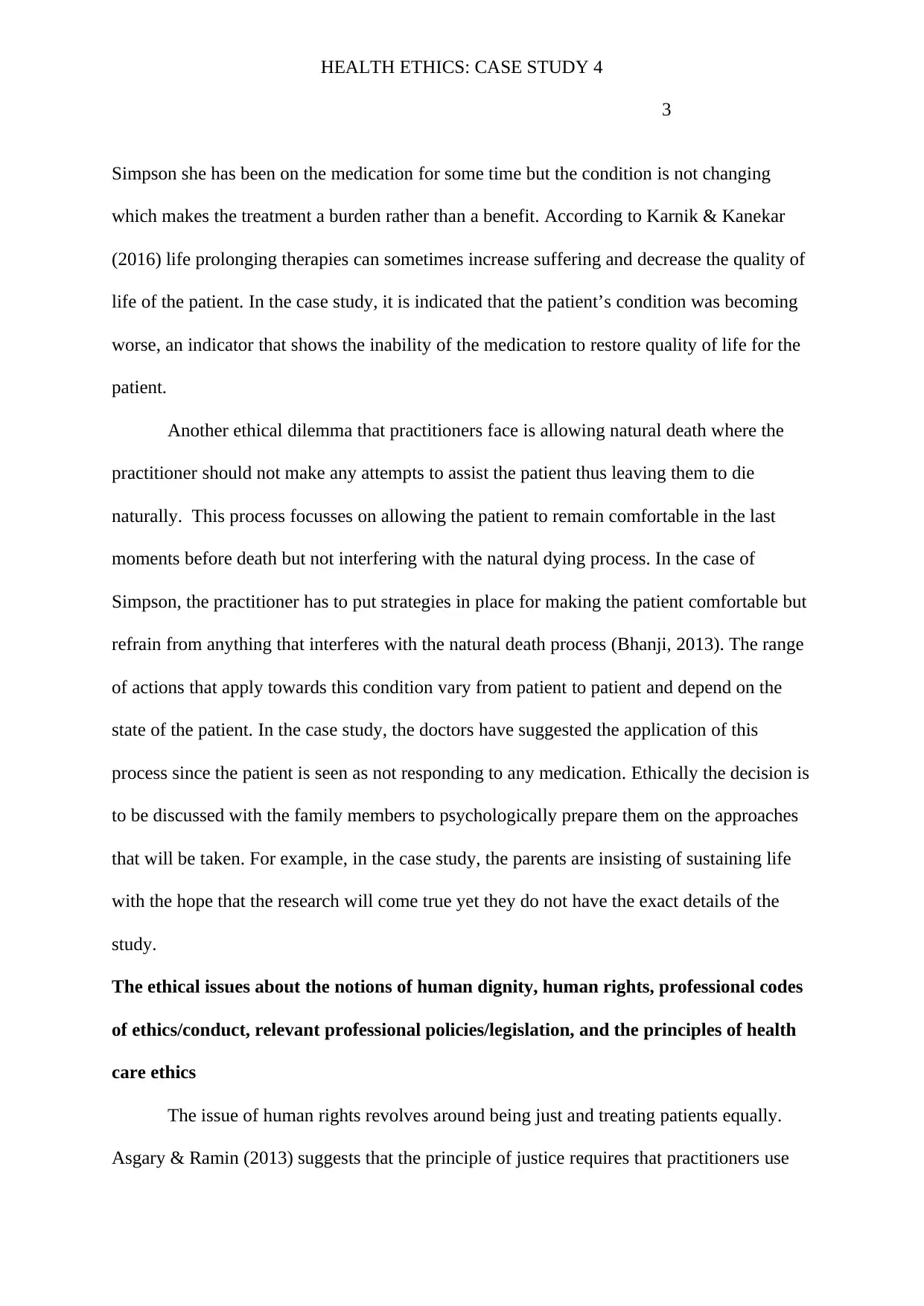
HEALTH ETHICS: CASE STUDY 4
3
Simpson she has been on the medication for some time but the condition is not changing
which makes the treatment a burden rather than a benefit. According to Karnik & Kanekar
(2016) life prolonging therapies can sometimes increase suffering and decrease the quality of
life of the patient. In the case study, it is indicated that the patient’s condition was becoming
worse, an indicator that shows the inability of the medication to restore quality of life for the
patient.
Another ethical dilemma that practitioners face is allowing natural death where the
practitioner should not make any attempts to assist the patient thus leaving them to die
naturally. This process focusses on allowing the patient to remain comfortable in the last
moments before death but not interfering with the natural dying process. In the case of
Simpson, the practitioner has to put strategies in place for making the patient comfortable but
refrain from anything that interferes with the natural death process (Bhanji, 2013). The range
of actions that apply towards this condition vary from patient to patient and depend on the
state of the patient. In the case study, the doctors have suggested the application of this
process since the patient is seen as not responding to any medication. Ethically the decision is
to be discussed with the family members to psychologically prepare them on the approaches
that will be taken. For example, in the case study, the parents are insisting of sustaining life
with the hope that the research will come true yet they do not have the exact details of the
study.
The ethical issues about the notions of human dignity, human rights, professional codes
of ethics/conduct, relevant professional policies/legislation, and the principles of health
care ethics
The issue of human rights revolves around being just and treating patients equally.
Asgary & Ramin (2013) suggests that the principle of justice requires that practitioners use
3
Simpson she has been on the medication for some time but the condition is not changing
which makes the treatment a burden rather than a benefit. According to Karnik & Kanekar
(2016) life prolonging therapies can sometimes increase suffering and decrease the quality of
life of the patient. In the case study, it is indicated that the patient’s condition was becoming
worse, an indicator that shows the inability of the medication to restore quality of life for the
patient.
Another ethical dilemma that practitioners face is allowing natural death where the
practitioner should not make any attempts to assist the patient thus leaving them to die
naturally. This process focusses on allowing the patient to remain comfortable in the last
moments before death but not interfering with the natural dying process. In the case of
Simpson, the practitioner has to put strategies in place for making the patient comfortable but
refrain from anything that interferes with the natural death process (Bhanji, 2013). The range
of actions that apply towards this condition vary from patient to patient and depend on the
state of the patient. In the case study, the doctors have suggested the application of this
process since the patient is seen as not responding to any medication. Ethically the decision is
to be discussed with the family members to psychologically prepare them on the approaches
that will be taken. For example, in the case study, the parents are insisting of sustaining life
with the hope that the research will come true yet they do not have the exact details of the
study.
The ethical issues about the notions of human dignity, human rights, professional codes
of ethics/conduct, relevant professional policies/legislation, and the principles of health
care ethics
The issue of human rights revolves around being just and treating patients equally.
Asgary & Ramin (2013) suggests that the principle of justice requires that practitioners use
⊘ This is a preview!⊘
Do you want full access?
Subscribe today to unlock all pages.

Trusted by 1+ million students worldwide
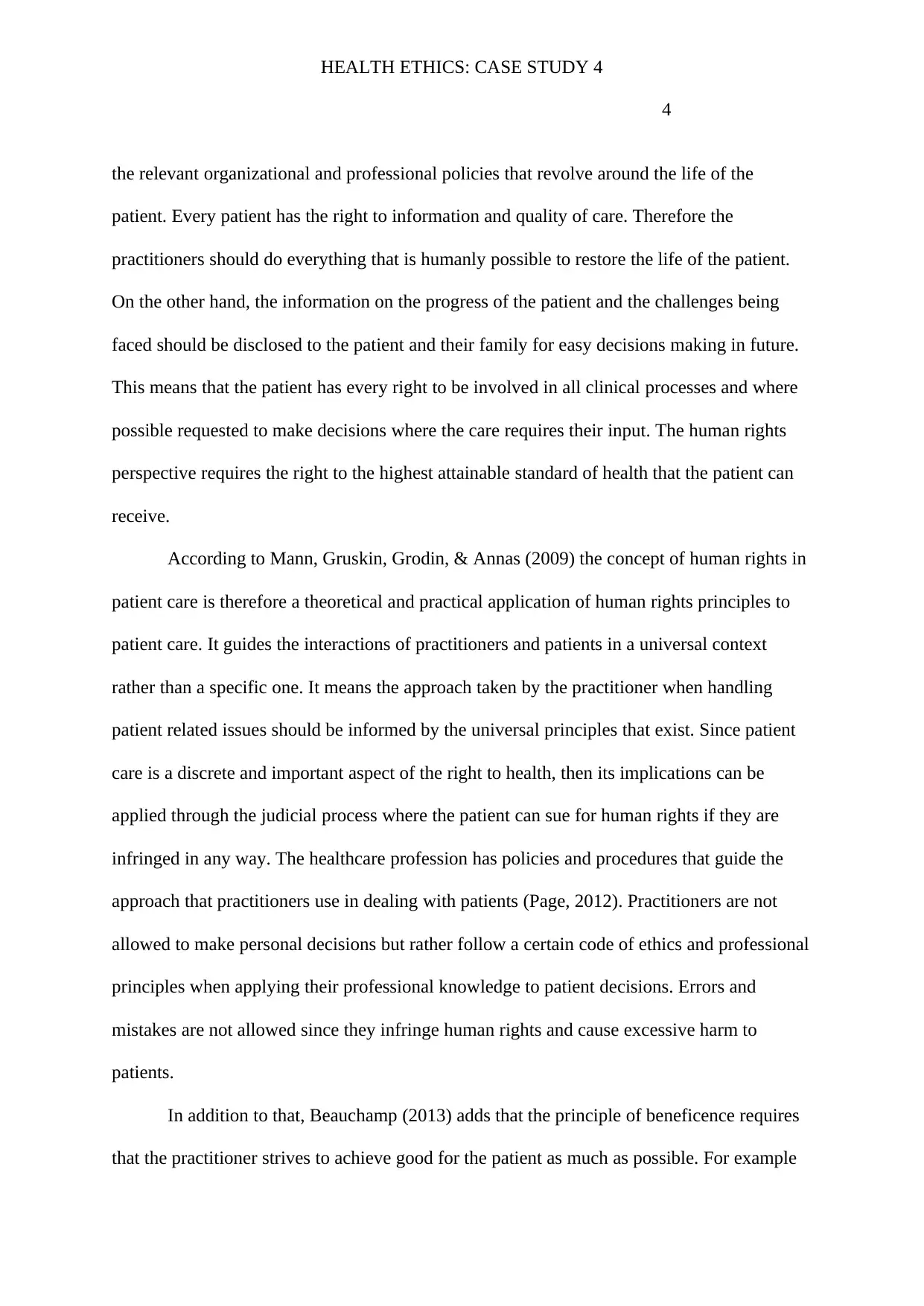
HEALTH ETHICS: CASE STUDY 4
4
the relevant organizational and professional policies that revolve around the life of the
patient. Every patient has the right to information and quality of care. Therefore the
practitioners should do everything that is humanly possible to restore the life of the patient.
On the other hand, the information on the progress of the patient and the challenges being
faced should be disclosed to the patient and their family for easy decisions making in future.
This means that the patient has every right to be involved in all clinical processes and where
possible requested to make decisions where the care requires their input. The human rights
perspective requires the right to the highest attainable standard of health that the patient can
receive.
According to Mann, Gruskin, Grodin, & Annas (2009) the concept of human rights in
patient care is therefore a theoretical and practical application of human rights principles to
patient care. It guides the interactions of practitioners and patients in a universal context
rather than a specific one. It means the approach taken by the practitioner when handling
patient related issues should be informed by the universal principles that exist. Since patient
care is a discrete and important aspect of the right to health, then its implications can be
applied through the judicial process where the patient can sue for human rights if they are
infringed in any way. The healthcare profession has policies and procedures that guide the
approach that practitioners use in dealing with patients (Page, 2012). Practitioners are not
allowed to make personal decisions but rather follow a certain code of ethics and professional
principles when applying their professional knowledge to patient decisions. Errors and
mistakes are not allowed since they infringe human rights and cause excessive harm to
patients.
In addition to that, Beauchamp (2013) adds that the principle of beneficence requires
that the practitioner strives to achieve good for the patient as much as possible. For example
4
the relevant organizational and professional policies that revolve around the life of the
patient. Every patient has the right to information and quality of care. Therefore the
practitioners should do everything that is humanly possible to restore the life of the patient.
On the other hand, the information on the progress of the patient and the challenges being
faced should be disclosed to the patient and their family for easy decisions making in future.
This means that the patient has every right to be involved in all clinical processes and where
possible requested to make decisions where the care requires their input. The human rights
perspective requires the right to the highest attainable standard of health that the patient can
receive.
According to Mann, Gruskin, Grodin, & Annas (2009) the concept of human rights in
patient care is therefore a theoretical and practical application of human rights principles to
patient care. It guides the interactions of practitioners and patients in a universal context
rather than a specific one. It means the approach taken by the practitioner when handling
patient related issues should be informed by the universal principles that exist. Since patient
care is a discrete and important aspect of the right to health, then its implications can be
applied through the judicial process where the patient can sue for human rights if they are
infringed in any way. The healthcare profession has policies and procedures that guide the
approach that practitioners use in dealing with patients (Page, 2012). Practitioners are not
allowed to make personal decisions but rather follow a certain code of ethics and professional
principles when applying their professional knowledge to patient decisions. Errors and
mistakes are not allowed since they infringe human rights and cause excessive harm to
patients.
In addition to that, Beauchamp (2013) adds that the principle of beneficence requires
that the practitioner strives to achieve good for the patient as much as possible. For example
Paraphrase This Document
Need a fresh take? Get an instant paraphrase of this document with our AI Paraphraser
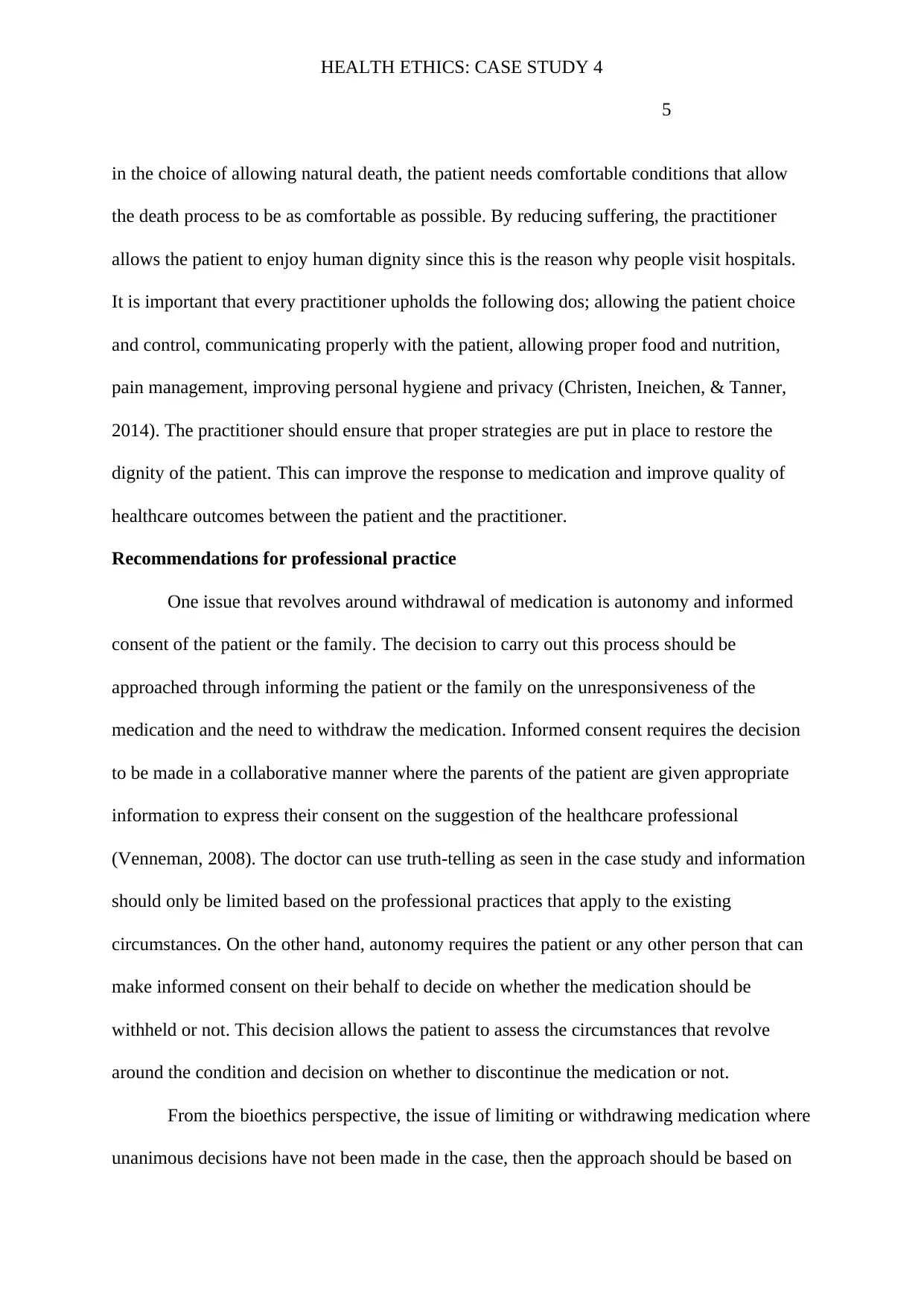
HEALTH ETHICS: CASE STUDY 4
5
in the choice of allowing natural death, the patient needs comfortable conditions that allow
the death process to be as comfortable as possible. By reducing suffering, the practitioner
allows the patient to enjoy human dignity since this is the reason why people visit hospitals.
It is important that every practitioner upholds the following dos; allowing the patient choice
and control, communicating properly with the patient, allowing proper food and nutrition,
pain management, improving personal hygiene and privacy (Christen, Ineichen, & Tanner,
2014). The practitioner should ensure that proper strategies are put in place to restore the
dignity of the patient. This can improve the response to medication and improve quality of
healthcare outcomes between the patient and the practitioner.
Recommendations for professional practice
One issue that revolves around withdrawal of medication is autonomy and informed
consent of the patient or the family. The decision to carry out this process should be
approached through informing the patient or the family on the unresponsiveness of the
medication and the need to withdraw the medication. Informed consent requires the decision
to be made in a collaborative manner where the parents of the patient are given appropriate
information to express their consent on the suggestion of the healthcare professional
(Venneman, 2008). The doctor can use truth-telling as seen in the case study and information
should only be limited based on the professional practices that apply to the existing
circumstances. On the other hand, autonomy requires the patient or any other person that can
make informed consent on their behalf to decide on whether the medication should be
withheld or not. This decision allows the patient to assess the circumstances that revolve
around the condition and decision on whether to discontinue the medication or not.
From the bioethics perspective, the issue of limiting or withdrawing medication where
unanimous decisions have not been made in the case, then the approach should be based on
5
in the choice of allowing natural death, the patient needs comfortable conditions that allow
the death process to be as comfortable as possible. By reducing suffering, the practitioner
allows the patient to enjoy human dignity since this is the reason why people visit hospitals.
It is important that every practitioner upholds the following dos; allowing the patient choice
and control, communicating properly with the patient, allowing proper food and nutrition,
pain management, improving personal hygiene and privacy (Christen, Ineichen, & Tanner,
2014). The practitioner should ensure that proper strategies are put in place to restore the
dignity of the patient. This can improve the response to medication and improve quality of
healthcare outcomes between the patient and the practitioner.
Recommendations for professional practice
One issue that revolves around withdrawal of medication is autonomy and informed
consent of the patient or the family. The decision to carry out this process should be
approached through informing the patient or the family on the unresponsiveness of the
medication and the need to withdraw the medication. Informed consent requires the decision
to be made in a collaborative manner where the parents of the patient are given appropriate
information to express their consent on the suggestion of the healthcare professional
(Venneman, 2008). The doctor can use truth-telling as seen in the case study and information
should only be limited based on the professional practices that apply to the existing
circumstances. On the other hand, autonomy requires the patient or any other person that can
make informed consent on their behalf to decide on whether the medication should be
withheld or not. This decision allows the patient to assess the circumstances that revolve
around the condition and decision on whether to discontinue the medication or not.
From the bioethics perspective, the issue of limiting or withdrawing medication where
unanimous decisions have not been made in the case, then the approach should be based on
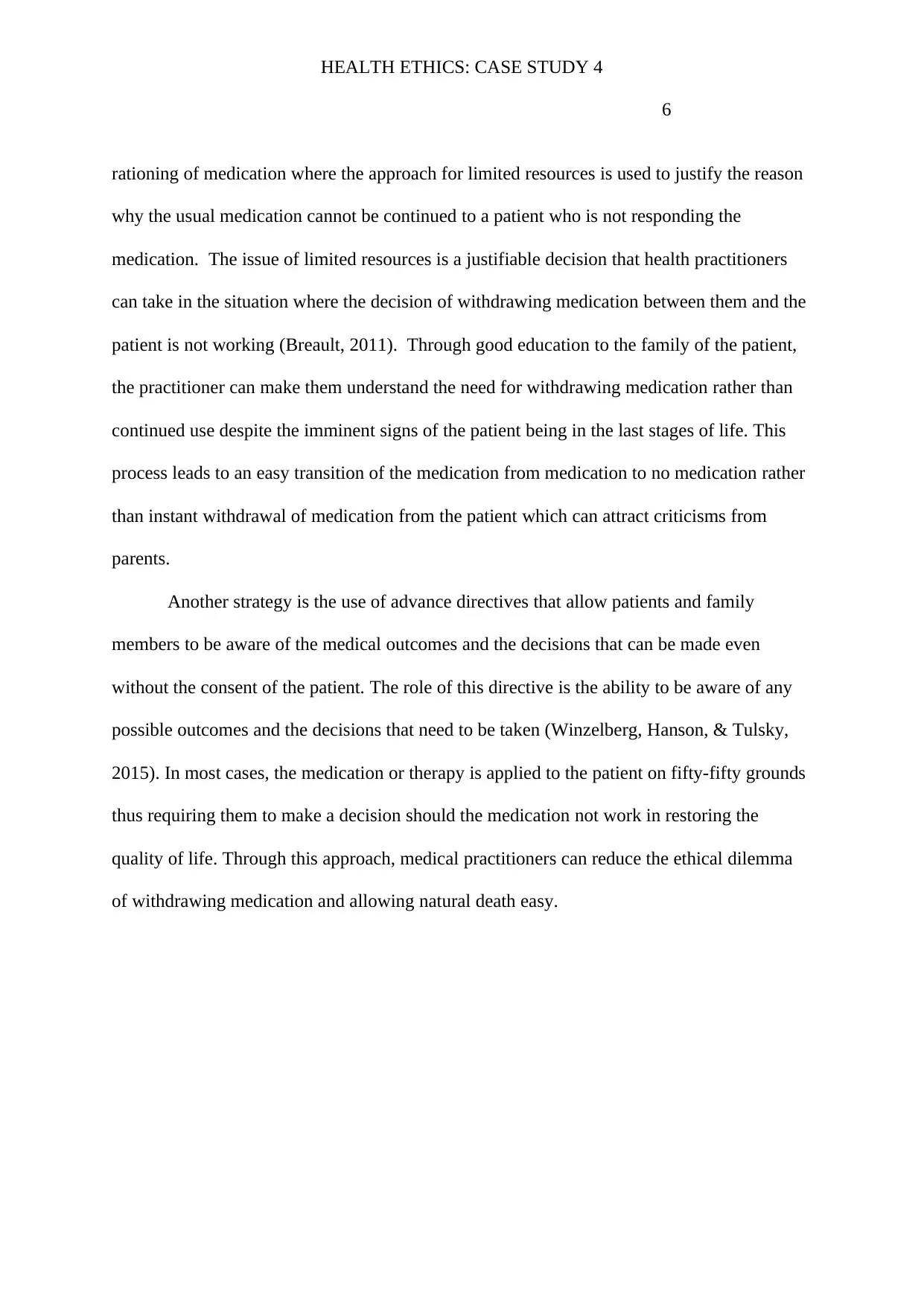
HEALTH ETHICS: CASE STUDY 4
6
rationing of medication where the approach for limited resources is used to justify the reason
why the usual medication cannot be continued to a patient who is not responding the
medication. The issue of limited resources is a justifiable decision that health practitioners
can take in the situation where the decision of withdrawing medication between them and the
patient is not working (Breault, 2011). Through good education to the family of the patient,
the practitioner can make them understand the need for withdrawing medication rather than
continued use despite the imminent signs of the patient being in the last stages of life. This
process leads to an easy transition of the medication from medication to no medication rather
than instant withdrawal of medication from the patient which can attract criticisms from
parents.
Another strategy is the use of advance directives that allow patients and family
members to be aware of the medical outcomes and the decisions that can be made even
without the consent of the patient. The role of this directive is the ability to be aware of any
possible outcomes and the decisions that need to be taken (Winzelberg, Hanson, & Tulsky,
2015). In most cases, the medication or therapy is applied to the patient on fifty-fifty grounds
thus requiring them to make a decision should the medication not work in restoring the
quality of life. Through this approach, medical practitioners can reduce the ethical dilemma
of withdrawing medication and allowing natural death easy.
6
rationing of medication where the approach for limited resources is used to justify the reason
why the usual medication cannot be continued to a patient who is not responding the
medication. The issue of limited resources is a justifiable decision that health practitioners
can take in the situation where the decision of withdrawing medication between them and the
patient is not working (Breault, 2011). Through good education to the family of the patient,
the practitioner can make them understand the need for withdrawing medication rather than
continued use despite the imminent signs of the patient being in the last stages of life. This
process leads to an easy transition of the medication from medication to no medication rather
than instant withdrawal of medication from the patient which can attract criticisms from
parents.
Another strategy is the use of advance directives that allow patients and family
members to be aware of the medical outcomes and the decisions that can be made even
without the consent of the patient. The role of this directive is the ability to be aware of any
possible outcomes and the decisions that need to be taken (Winzelberg, Hanson, & Tulsky,
2015). In most cases, the medication or therapy is applied to the patient on fifty-fifty grounds
thus requiring them to make a decision should the medication not work in restoring the
quality of life. Through this approach, medical practitioners can reduce the ethical dilemma
of withdrawing medication and allowing natural death easy.
⊘ This is a preview!⊘
Do you want full access?
Subscribe today to unlock all pages.

Trusted by 1+ million students worldwide
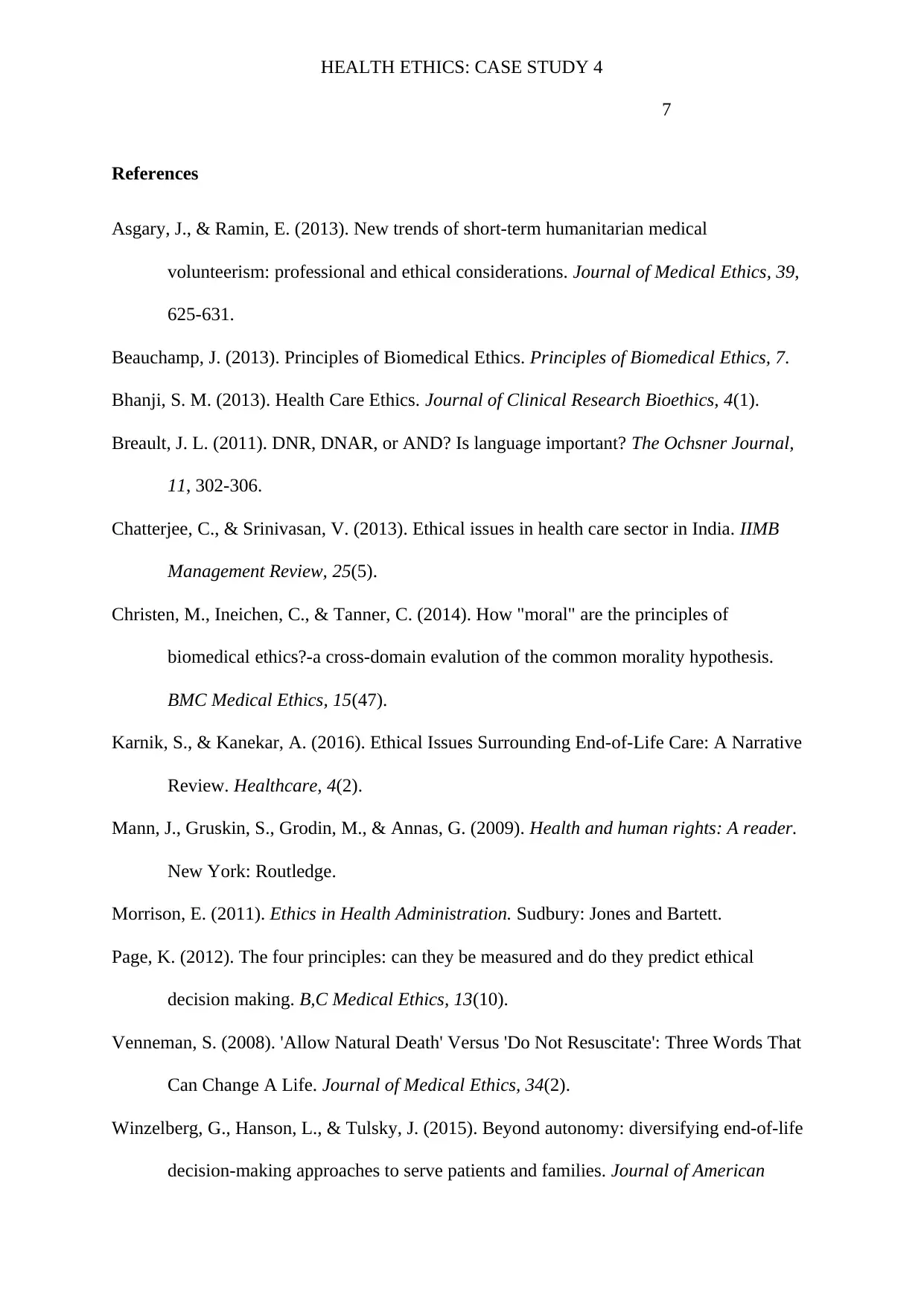
HEALTH ETHICS: CASE STUDY 4
7
References
Asgary, J., & Ramin, E. (2013). New trends of short-term humanitarian medical
volunteerism: professional and ethical considerations. Journal of Medical Ethics, 39,
625-631.
Beauchamp, J. (2013). Principles of Biomedical Ethics. Principles of Biomedical Ethics, 7.
Bhanji, S. M. (2013). Health Care Ethics. Journal of Clinical Research Bioethics, 4(1).
Breault, J. L. (2011). DNR, DNAR, or AND? Is language important? The Ochsner Journal,
11, 302-306.
Chatterjee, C., & Srinivasan, V. (2013). Ethical issues in health care sector in India. IIMB
Management Review, 25(5).
Christen, M., Ineichen, C., & Tanner, C. (2014). How "moral" are the principles of
biomedical ethics?-a cross-domain evalution of the common morality hypothesis.
BMC Medical Ethics, 15(47).
Karnik, S., & Kanekar, A. (2016). Ethical Issues Surrounding End-of-Life Care: A Narrative
Review. Healthcare, 4(2).
Mann, J., Gruskin, S., Grodin, M., & Annas, G. (2009). Health and human rights: A reader.
New York: Routledge.
Morrison, E. (2011). Ethics in Health Administration. Sudbury: Jones and Bartett.
Page, K. (2012). The four principles: can they be measured and do they predict ethical
decision making. B,C Medical Ethics, 13(10).
Venneman, S. (2008). 'Allow Natural Death' Versus 'Do Not Resuscitate': Three Words That
Can Change A Life. Journal of Medical Ethics, 34(2).
Winzelberg, G., Hanson, L., & Tulsky, J. (2015). Beyond autonomy: diversifying end-of-life
decision-making approaches to serve patients and families. Journal of American
7
References
Asgary, J., & Ramin, E. (2013). New trends of short-term humanitarian medical
volunteerism: professional and ethical considerations. Journal of Medical Ethics, 39,
625-631.
Beauchamp, J. (2013). Principles of Biomedical Ethics. Principles of Biomedical Ethics, 7.
Bhanji, S. M. (2013). Health Care Ethics. Journal of Clinical Research Bioethics, 4(1).
Breault, J. L. (2011). DNR, DNAR, or AND? Is language important? The Ochsner Journal,
11, 302-306.
Chatterjee, C., & Srinivasan, V. (2013). Ethical issues in health care sector in India. IIMB
Management Review, 25(5).
Christen, M., Ineichen, C., & Tanner, C. (2014). How "moral" are the principles of
biomedical ethics?-a cross-domain evalution of the common morality hypothesis.
BMC Medical Ethics, 15(47).
Karnik, S., & Kanekar, A. (2016). Ethical Issues Surrounding End-of-Life Care: A Narrative
Review. Healthcare, 4(2).
Mann, J., Gruskin, S., Grodin, M., & Annas, G. (2009). Health and human rights: A reader.
New York: Routledge.
Morrison, E. (2011). Ethics in Health Administration. Sudbury: Jones and Bartett.
Page, K. (2012). The four principles: can they be measured and do they predict ethical
decision making. B,C Medical Ethics, 13(10).
Venneman, S. (2008). 'Allow Natural Death' Versus 'Do Not Resuscitate': Three Words That
Can Change A Life. Journal of Medical Ethics, 34(2).
Winzelberg, G., Hanson, L., & Tulsky, J. (2015). Beyond autonomy: diversifying end-of-life
decision-making approaches to serve patients and families. Journal of American
Paraphrase This Document
Need a fresh take? Get an instant paraphrase of this document with our AI Paraphraser
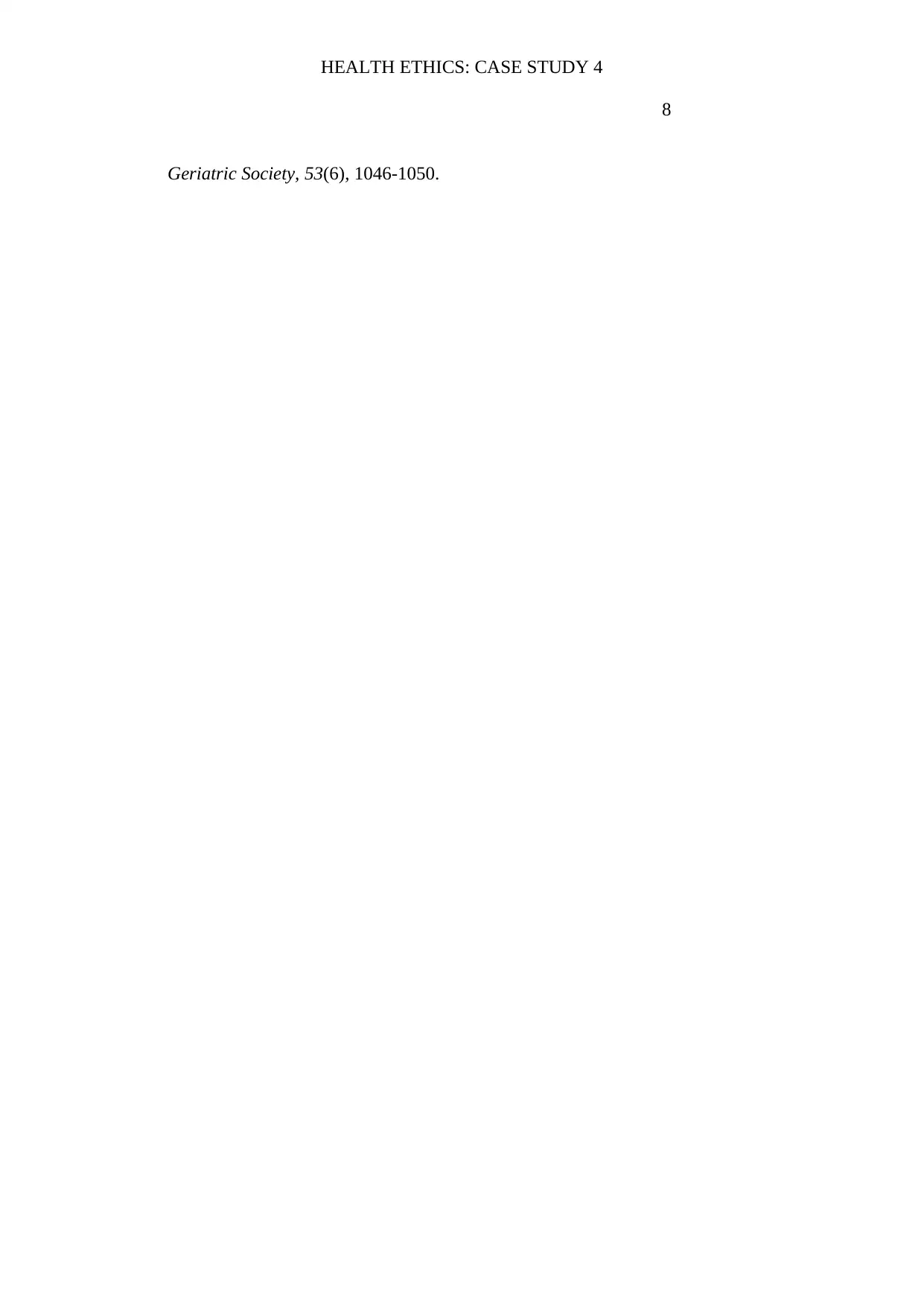
HEALTH ETHICS: CASE STUDY 4
8
Geriatric Society, 53(6), 1046-1050.
8
Geriatric Society, 53(6), 1046-1050.
1 out of 8
Related Documents
Your All-in-One AI-Powered Toolkit for Academic Success.
+13062052269
info@desklib.com
Available 24*7 on WhatsApp / Email
![[object Object]](/_next/static/media/star-bottom.7253800d.svg)
Unlock your academic potential
Copyright © 2020–2025 A2Z Services. All Rights Reserved. Developed and managed by ZUCOL.





